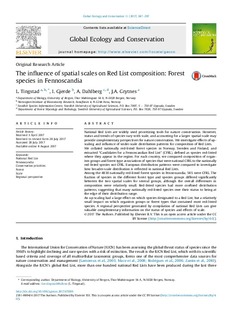| dc.contributor.author | Tingstad, Lise | |
| dc.contributor.author | Gjerde, Ivar | |
| dc.contributor.author | Dahlberg, Anders | |
| dc.contributor.author | Grytnes, John-Arvid | |
| dc.coverage.spatial | Fennoscandia | nb_NO |
| dc.date.accessioned | 2018-04-10T14:28:19Z | |
| dc.date.available | 2018-04-10T14:28:19Z | |
| dc.date.created | 2017-10-26T12:48:40Z | |
| dc.date.issued | 2017-08-08 | |
| dc.identifier.citation | Global Ecology and Conservation. 2017, 11 247-297. | nb_NO |
| dc.identifier.issn | 2351-9894 | |
| dc.identifier.uri | http://hdl.handle.net/11250/2493502 | |
| dc.description.abstract | National Red Lists are widely used prioritizing tools for nature conservation. However, status and trends of species vary with scale, and accounting for a larger spatial scale may provide complementary perspectives for nature conservation.We investigate effects of upscaling and influence of wider-scale distribution patterns for composition of Red Lists. We collated nationally red-listed forest species in Norway, Sweden and Finland, and extracted “Candidates for a Fennoscandian Red List” (CFRL), defined as species red-listed where they appear in the region. For each country, we compared composition of organism groups and forest type associations of species that were national CFRL to the nationally red-listed species not CFRL. European distribution patterns were compared to investigate how broader-scale distribution is reflected in national Red Lists. Among the 4830 nationally red-listed forest species in Fennoscandia, 58% were CFRL. The fraction of species in the different forest type and species groups differed significantly between the two spatial scales for several groups, although the overall differences in composition were relatively small. Red-listed species had more confined distribution patterns, suggesting that many nationally red-listed species owe their status to being at the edge of their distribution range. An up-scaling had a large effect on which species designated to a Red List, but a relatively small impact on which organism groups or forest types that contained most red-listed species. A regional perspective generated by compilation of national Red Lists can give valuable complementary information on the status of species and effects of scale. | nb_NO |
| dc.language.iso | eng | nb_NO |
| dc.publisher | Elsevier | nb_NO |
| dc.rights | Navngivelse 4.0 Internasjonal | * |
| dc.rights.uri | http://creativecommons.org/licenses/by/4.0/deed.no | * |
| dc.subject | National Red List | nb_NO |
| dc.subject | Conservation priorities | nb_NO |
| dc.subject | Forest | nb_NO |
| dc.subject | Scale | nb_NO |
| dc.subject | Regional perspective | nb_NO |
| dc.title | The influence of spatial scales on Red List composition: Forest species in Fennoscandia | nb_NO |
| dc.type | Journal article | nb_NO |
| dc.type | Peer reviewed | nb_NO |
| dc.description.version | publishedVersion | nb_NO |
| dc.rights.holder | © 2017 The Authors. Published by Elsevier B.V. | nb_NO |
| dc.source.pagenumber | 247-297 | nb_NO |
| dc.source.volume | 11 | nb_NO |
| dc.source.journal | Global Ecology and Conservation | nb_NO |
| dc.identifier.doi | 10.1016/j.gecco.2017.07.005 | |
| dc.identifier.cristin | 1507988 | |
| cristin.ispublished | true | |
| cristin.fulltext | original | |
| cristin.qualitycode | 1 | |

